C3 The creed of Johann Sebastian Bach in picture and sound
The music of Johann Sebastian Bach is so rich that experts will be dealing with it for decades and continue to benefit. It is well known that the art of the fugue contains an unfinished piece: Contrapunctus 14, which breaks off abruptly. One of Bach's sons, Carl Philipp Emanuel, added the last page later: "The author died over this fugue, where the name B A C H was placed in the contrasubject."

J.S.Bach: Autograph of Contrapunctus 14 with the handwritten annotation by Carl Philipp Emanuel Bach
Since then, much has been puzzled over the "musical signature" of the piece, as well as how the end of the performance was thought. The contraction of various sources now provides clarity in this regard.

Valerius Herberger's book on Jesus Sirach of 1739 brought the author to the track as he wrote: "As the name sounds, life should be" - and the name Bach actually sounds. Herberger also translates the saying "Esto quod audis" with the words "How to tithe you, so you should also hold. The mere name does not matter, the proof also belongs to it."
The corresponding context can be found in Luke 10,20, which says, "Rejoice that your names are written in heaven." The text was the subject of numerous commentaries - as in the death bible of Friedrich Trescho - because he gives comfort in so far as it deserves the righteous by a virtuous life, one day to be called by name to share in the blessedness. We also hear about this in a hymn by Solomon Franck, whom Johann Sebastian Bach personally knew and who provided numerous texts for his cantatas during the Weimar period. Here only the first and last verse of the song "I am written in heaven":
1 "I am written in heaven,
I am a child of bliss.
What can sin grieve me and all suffering of this time?
I know that from the beginning, chosen in Christ."
5 "No devil shall take away my consolation,
that I chose from the beginning,
that I am by grace through faith redeemed in Christ's blood.
So I live and die on it; On Christ I closed my run."
Said and done: Shortly after hearing the name B-A-C-H, Contrapunctus 14 breaks off. The sound of the notes is completed as if the composer had reached the end of his musical track. There can be no question of a signature. What would it make sense, since the composer's name is usually written on the front page? Reason for such an approach is the high appreciation of music as a gift of God: MUSICA DONUM DEI. By God in heaven - not on the sheet of music - his name is written, so Bach's firm belief. No doubt that he was able to identify with the text written in first-person form, which can now be taken over into the long series of works by Solomon Franck, although the type of setting is different. Text, but no longer needs it, and yet evokes the desired affects, as Lorenz Mizler described in the sixth part of his newly opened music library in 1739, where he speaks of "talking sounds" whose message would be felt, "even if there were no words included just by using the instruments." If it were a traditional setting, the listener would have the opportunity to identify himself with the ego form of the lyrics. But so the composer sets his personal creed and creates for this a privacy that only the initiated have access to - and if the son had not posthumously pointed out that the name could be read in the notes, any proof would be missing.
The cultural-historical background is formed by the Christian symbolism of Western harmony since the 3rd century AD, which was still a living cultural asset in Bach's time and was recently rediscovered by the author. Some of the following blog posts and presentations are about it. Johann Heinrich Buttstett (*1666-†1727) gives an impression of the perspective at the time when he writes: "Caput. VI. Prove that the music will last forever, and that one day music will be played in heaven with exactly those sounds, we use here in the world." According to ecclesiastical notion, music and bliss were inseparable and formed the prettier part of a worldview defended by the most cruel means - because when it came to power interests, harmony, love of the enemy, wisdom, and even the ten commandments did not matter.
The Corresponding Society of Musical Sciences founded by Lorenz Mizler, which Bach belonged to, was particularly concerned to restore "the majesty of ancient music", which threatened to be endangered by the free spirit of the Enlightenment. For this reason, Bach presented the law firm with the Art of the Fugue as an annual gift. As mentioned, although we hear from Carl Philipp Emanuel that the father passed away through Contrapunctus 14 - and the seemingly unfinished work seems to confirm this - the whole thing, as the Würzburg University Professor for Organ and CMD Christoph Bossert repeatedly emphasized, is rather more the character of a compositional staging, especially since Bach, as we can now see, should have seen his time of death quite precisely beforehand in order to make what he said become reality directly - and not only musically.
Thus, the art of the fugue can be regarded as finished during his lifetime and closes with this touching credo, still exaggerated by the son's commentary on the deceased father - as if God had heard it and ordered it directly because of the creed. However, it will rather be in a way that Carl Philipp Emanuel found only the one unfinished seeming sheet and drew the obvious conclusion that his father was unable to complete this work.
From the reading of Valerius Herberger further references to the partnership, to Johann Sebastian Bach and especially to the art of the fugue - to the partnership result in so far as the embossed medal shows a swarm of bees, which according to Lorenz Mizler embodies the diligence of the partnership members. Of course, Bach knew about it.
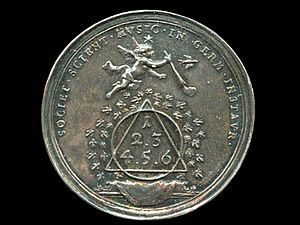
Solicitor Medal, Stadtgeschichtliches Museum, Leipzig
Herberger dedicates a separate section to the bees and compares their virtues with those of a righteous landlord: "The little bee lives best and besty in green meadows, forests and flowing waters: So a godly Hauss-With should like to live and be found in the church, where the word of God is preached. The Holy Bible is the beautiful airy forest of lofty flowers, says the Lord Luther, and the green meadow is the gospel, as David praises: He grazes me in a green meadow, and leads me to the fresh water, Ps. 23: 1. There are the right Heyl fountains, of which Esaias speaks cap.12,3. You will be happy to draw water from the Heyl Fountain. Then a pious man may thresh, like a tree planted by the brooks of water, which yields his fruit in his day, and his leaves do not wither, and what he does, that is well, Ps. 1: 3." If we then look at the floral decor of the score, it is noticeable that at the end of the fifth piece it gives the view of a landscape which, with its trees, can certainly be compared to an aureole.

Bach Archive Leipzig, end of Contrapunctus 5
And even before that, at the end of the 4th piece, medicinal plants are striking at prominent positions, e.g. the hawthorn on the staves or the cornflower in the center.
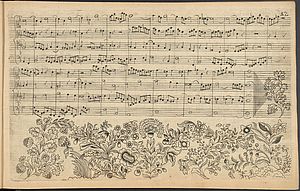
Bach Archive Leipzig, end of Contrapunctus 4
The cornflower was of particular importance to Bach, as she was able to relieve his constantly overworked eyes. Thus Pietro recommended Andrea Mattioli in his book of herbs of 1690: "The distilled cornflower water is very good / to the red liquid eyes / and other derselbigen heated infirmities / the day several times a few drops in the eyes." Nevertheless, his suffering was in the end so great that he was ready to undergo a risky and painful eye surgery, which, however, did not bring the desired success. As we know, he passed away shortly thereafter.
Analogous to the appearance of his name in the music of heaven, we also find in the floral decoration of his work an indication that he entrusted himself to his Creator, for in the grand final sweep a plant is presented, which consists of parts of various species, among which we discover also the cornflower again. The large flower of this plant is directly facing the viewer and despite stylization undoubtedly identifiable as a passion flower. But while the passiflora incarnata usually has 10 petals - which in a traditional reading to the 12 disciples minus Judas and Peter as a result of betrayal and the three times denied - we count here 14, according to the symbolism of the name Bach: A = 1, B = 2 , C = 3, H = 8; 1 + 2 + 3 + 8 = 14
It is the compositional intention that this optical conclusion coincides with the acoustic and the green floodplain allows a foresight on what comes after the end. According to Christian doctrine, this is due solely to the Passion of Christ - but the symbol numbers reveal that Bach also dealt here with his personal end. His name, as well as his fate, are linked to the Savior's suffering. Figurative here is said the same as in the lyrics of Solomon Franck quoted above: "... that I am redeemed by grace by faith in Christ's blood, so I live and die on it, on Christ I close my course."
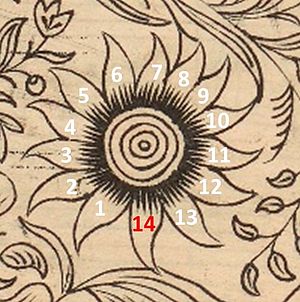
Bach Archive Leipzig, detail Contrapunctus 5, numbers from the author
Furthermore, it can hardly be overlooked that he linked his name directly to the above mentioned fresh water and the water streams of the green floodplain. On the meaning of the name, Valerius Herberger repeatedly points out: "An honest name is a great gift of God.", Or elsewhere: "A good name comes from an incorruptible life and next to a gracious God and good conscience there is no greater treasure in a good name for the world." On the example of the name of Josiah he explains in particular: "The name of Josiah is noble as incense from the pharmacies, he is sweet, like honey in the mouth, and like music with wine."
For the mediation of such a personal relationship with God, the art forms of the Fugue and the Canon are the first choice, for it is not without reason that Valerius Herberger, in connection with repetitions in sermons, writes: "... which is necessary and useful, one must say it openly and diligently and through push a variety of repetition into the heart."
Also in the plants we find the stylistic means of repetition, as seen in the example of the cornflower, but also the bluebell, the forget-me-not, the clove and various berries can be found several times. Such a complex design with personal content leaves to no other conclusion than that Bach made the template himself by hand. Could a music engraver have taken the liberty of adding floral decor to the score? The hedge-forming hawthorn used for this purpose, also called hawthorn, still hints at note level that something else is coming. He separates the musical from the visual as if it were the enclosure of a garden. Musically speaking, the function of a musical clef comes to him as if he wants to tell us: "What follows now, is in the key of the visible and therefore no longer needs lines." Outside the staves, the curved branch would not be associated with the characteristic silhouette of the alto key. The position at this point is therefore not the result of a horror vacui, but compositional intention. This includes the continuation of the reading direction from left to right, symmetries that are perceived in music as reflections, including. It is a work that lives on spiritually when the last chord has died away. The staff lines on this sheet will be empty this time. Only the instrument of the pencil informs of the green field.
It is a pronounced special case that a composer of the order of magnitude J.S.Bachs communicates his associative pictorial associations and thoughts together with the music and for this suddenly transfers from the art of sound into the depicting mode. In doing so, he includes biographical information because he identifies with the matter unconditionally, and it can not be ruled out that in this way he would like to draw attention to a special symbolic content in his work. This salary can only be theological and will address in a special way the desire of the law firm to restore the majesty of ancient music. This is suggested by the importance of reflection, which we encounter in many places in his work as well as in his monogram.

If we remain in the picture, it is the reflection of the green floodplain both in his music and in his name - Bach: "In the mirror of the water, you recognize your face and in the mirror of your thoughts, you recognize yourself." Prov. 27:19; "Now we only see an unclear picture like in a dim mirror, but then we look God in the face." 1st Cor. 13.12
It was literally nearby that he got to know passion flowers and pelargoniums in the Botanical Garden of the University of Leipzig - at that time located between the Paulinerchurch and the Princes-House - and that the impression led him to reproduce them in his work as special wonders of creation. It is as if he had immediately implemented the recommendation of Valerius Herberger: "Drish it like bees, pass with your mind through the meadows of the Holy Scripture and through the most beautiful flowers of the most famous fathers and make you honey-fair of faith."
An example of the indispensable need to look at cultural assets in context and from the spiritual perspective of their origin. With symbolism, nothing should be hidden - but rather made clear and pointed out, even if today we have to work into the perspective of time. In this respect, the art of the fugue is not comparable to the puzzle canon of the two Haussmann Bach portraits. Such an impression - as well as the idea of a musical signature - can only arise in a society that has completely lost access to the cultural history of its own sound system, which can not be explained without the inclusion of Christian symbolism.
The characteristic of Bach lies in the depth of his faith, his feeling and devotion combined with mathematical clarity - an equivalence, which can be found in the law firm medal and in the philosophy of Christian Wolff (* 1679 - † 1754), the advocate of a congruence between reason and Epiphany.
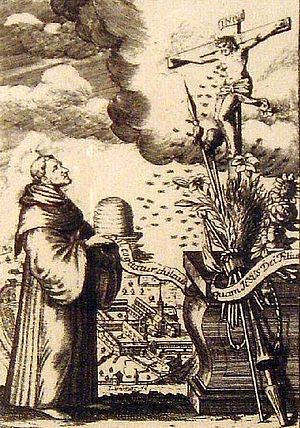
Josef Meglinger, "Cistercienser Year", 1700
It should be noted here in relation to the medal that the encounter of a bee colony with the Savior has a significant precursor. Both on an altar sheet (private property, Germany) and in Josef Meglinger's "Cistercineser Year", published in 1700 in print, we see Bernhard von Clairvaux - who received the epithet doctor mellifluus due to his honey-flowing sermons - with a beehive in front of an altar with the crucified. The bees ascend to the side wound of Jesus and on a banner we find the text. "Nil cogitatur dulcius quam JESUS Dei Filius", nothing sweeter can be thought of than Jesus, the Son of God. The flowers on the altar are symbolic bearers of meaning, so the lily stands for innocence, the rose for love and the sunflower, which always turns to the light, for permanence in faith.
On the symbolism of the plants
The plants selected by Bach can be divided into various categories: There are the medicinal herbs or medicinal herbs: cornflower, flax, hawthorn, on the other hand, those who serve the spiritual salvation: peony, Christmas rose, passion flower, bellflower, cardamom.
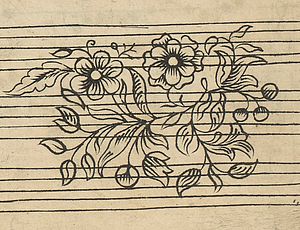
Bach Archive Leipzig, end Contrapunctus à 3 with liverwort, also called Herzfreude, and peony. In others, the name alone has a meaningfulness that is self-sufficient, such as Heartfelt or forget-me-not. The berries found have two qualities: the raspberry, the blueberry and the currant stand for the enjoyment, their sweetness and the pleasant consumption, especially the laurel for praise, recognition and honor.
In addition, there are also a number of plants that are not determinable because they have different flowers, leaves and fruits. They have purely decorative function and stand for the flowering in itself and for an overflowing vegetation. But especially the knight star deserves special consideration, since Bach brings him at least a hint of his own monogram in connection and thus immediately a parallel to the Lutherrose results. The name introduced by Charles von Linné for this genus of plants was not knight star but Amaryllis, and referred to the shepherd poems (Eclogae) of Virgil, the Bach were familiar from his schooldays ago.
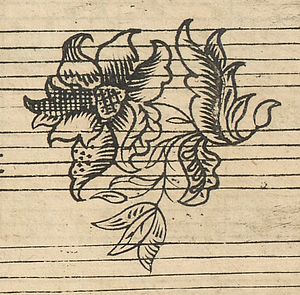
Bach Archive Leipzig, Canon alla duodecima, Ritterstern / Amaryllis
Especially from the fourth Eclogue, which was interpreted from an ecclesiastical point of view as an announcement of the Savior, there is an impulse of the new beginning and the departure into a new time, as it is expressed on the Soltätsmedaille with the shining morning star. Lorenz Mizler therefore speaks of the dawn in music. The combination of bluebell and amaryllis may point in this direction.
Another reference to Vergil is given by Friedrich Wilhelm Marpurg, to whom the formulation is attributed that Greece will have had only a Homer, Rome only a Vergil and Germany only a brook. Marpurg had the opportunity to meet Bach personally and wrote after his death the preliminary report on the art of the fugue. It can not be ruled out that Bach himself heard this tribute from Marpurg himself and therefore chose the laurel wreath around his monogram.
In the search for a plant of his choice - the rose had already been used by Luther - the Passiflora has apparently received the prize, because it is close to the Passion, while Luther had to help with the attributes of the heart and the cross, as well with his initials. On the number of petals alone, Bach becomes her silent component - without a seal and without vanity. Once again, Herberger may have been the point of reference, as he describes the Lutherrose and also deals with the vices of pride elsewhere. What counts alone is the quiet sincerity in faith and the attachment to the suffering of Christ. In the four concentric rings both a reference to the four evangelists and to the letters of the name Bach can be seen. Almost a circum locutio in a scholastic sense, which means placing God in the middle of thinking and one's own existence.
Reflections on the originally planned version
If we take up the idea that the scores and decor designs were on separate sheets, it could easily happen that they got mixed up after Bach's death, as was indeed the case. The floral ending with the Passiflora would be a perfect addition to the previously presented autographs of Contrapunctus 14 - as a grand and thought-provoking final of the entire work, which ends in two ways with the Bach number and the name inscribed in heaven. A most impressive and above all clear perceptible creed.

Reconstruction by the author
No matter which of the two versions was completed first, Bach had planned to end the play on half a line.
For the very last leaf was probably only the following introduced ornament of Contrapunctus 8 provided, which again summarizes the subject. In it we find the barely legible monogram, from which we conclude that Bach's eyesight was actually very limited at that time. The engraver, Johann Heinrich Schübler, can not be thanked enough to have meticulously documented the material submitted to him and not tried to improve it.
If we look at the work in its dynamic process, exactly this finale has been prepared by long hand and the number of floral attributes has been successively increased. May be that some unfinished drawings were put aside for a wile. Especially with the monogram of the last sheet, the impression arises that it was closest to his death hour. Everything else was certainly complete by this time. That Bach specifically kept his "signature" to the last would be understandable and a sign of the conscientious conclusion.
Consequently, the subsequent comment of the son unintentionally misled the research, as well as the fact that the intended order was not known. If we look at the first print again against this background, Schübler's embarrassment of having to put the decor in his place without knowing where he belongs, becomes evident. Therefore, some elements come dangerously close to the score for reasons of space and the conclusion meets us in the middle. According to the number of symbols alone, the art of the fugue was designed for exactly 14 pieces and all other sheets were intended for other publications.
The rediscovery of a "self portrait" by Johann Sebastian Bach and the interpretation of his seal
Consider the final ornamentation of Contrapunctus 8.

Bach Archive Leipzig, end Contrapunctus 8

Bach Archive Leipzig, end Contrapunctus 8, detail I
Immediately in the visual overture to the left, at the top of a laurel branch, a face smiles at us. If it were a drawing, it would probably be easily possible to misunderstand and misinterpret the perhaps randomly created five or six lines of just a few millimeters in length. Here, however, it is a lead plate into which each well had to be inverted in order to produce the desired image, i. Material was removed with the engraving stylus. The strokes are inside the circular laurel and go only a single point minimally beyond the contour. In addition, it is worth noting that it is the only laurel with internal sketch ever.
We look in a happy face. Clearly visible are the eyebrows, the mouth, the chin and two hairs as in a child's drawing: a brook smiley to a certain extent. Or did the music-engravor just had a funny day?
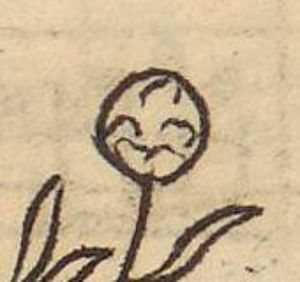
Bach Archive Leipzig, end of Contrapunctus 8, detail II
After all that we have learned so far about Bach's care, ingenuity and cleverness, we learn here that he is beyond his self-drawn laurels, i. Happy about the worldly glory - a greeting to posterity included - and the humorous way of showing that he does not take this self-praise nearly as seriously as the credo on the other pages. That is why it is worth noting what we do not see: the crown over his monogram like the one on his petition.

Bach seal with crown in octagonal version
Bach here prefers the laurel wreath according to ancient tradition as a sign of acquired merit. It would not be a long distance, in the absence of the crown, to see a sign of humility towards his Creator, who in the Off. of John 2:10 says, "Be faithful unto death, and I will give the crown of life unto you." For this, much more important crown, there was no alternative for him. Therefore, the young trees flanking his monogram symmetrically are nothing else than to be understood as reminiscent of the green floodplain, and the three flowers under his name and those three leaves above may refer to the Trinity with an allusion to Off. 21,6: "I am Alpha and Omega, the beginning and the end, in vain I will give to the thirsting of the spring of living water" - and again the name has its double meaning.

Bach Archive Leipzig, end Contrapunctus 8, detail III
Striking are the Kartäuserelken in the upper gussets (see detail I). Whether they already refer to the sentence that later became the order's motto: Stat crux dum volvitur orbis (The cross is fixed as the earth continues to revolve), but it still has to remain open.
The result is an interpretation of his seal, which, of course, takes into account the octogonal version, for it contains an indication of the eight delights we know from baptismal fonts, baptisteries, pulpits or in music from the octave. The presentation of this page titled "How the Octave got its name" presents further examples. Accordingly, the crown is not to be understood as an indication of the court compositeur, but on the crown of life and the content of the seal is conclusive: the name Bach - reflected in itself, which means: to consider in two ways and therefore ambiguous - makes the green floodplain recognizable in his music. Hence the leaves that surround his initials. It is his personal endeavor to attain the crown of life and salvation. Such a creed has nothing whatsoever to do with a secular title, and the depictions - both those on its seal and the conclusion of Contrapunctus 8 - are not heraldic but emblematic in nature.
The octagonal version of his petition was therefore also necessary as a delineation, so as not to give rise to the suspicion of a presumptuous title appropriation. Something framed is impossible to confuse with a coat of arms. Hence the emphasized width of the framing. Similarly, a flowered crown could not be misunderstood. The Thomaskantor was no nobility or royal dignity. But how a crown of life would look realiter, no one knew.
This interpretation explains why he was able to use the seal at a time when the title had not yet been awarded to him, but now it seems as though the self-drawn laurels made him aware that he might go too far with himself to crown. It is up to the Redeemer to do so. A crown over the name would actually be inappropriate in this emblem, as it would signal that he had already achieved immortality.
On the other hand, we now understand why it did not count on the number of flowers on the crown - we meet five or seven times - because it was not interpretable in heraldic sense. From a theological point of view, the number 5 can be associated with the 5 wounds, and the number 7 with the 7 gifts of the Holy Spirit. Both variants can be included equally.
The idea of a self-confident composer who proudly musically signs his work and then crowns himself in his own seal must be rejected completely because it has nothing to do with the humble, extremely diligent, humorous, humble, deeply religious and educated Bach, as we experience him here.
The modern interpretations of his seal are based on a heraldic approach, as they ignore the important framing and consequently lead in the wrong direction. A naive observer could therefore come up with the idea that it is the guild sign of an inn "Zur Krone" with attached garden.
If one imagines how Bach made the fair copy to the engraver's copy, sat down at a table and made after work all the thoughts on the floral decor, to express beyond the music, which filled his heart - and with limited vision with inadequate candle lighting - so the required dedication is not compatible with starry doors.
It is in keeping with the current zeitgeist to exclude the religious component and, above all, the symbolism of the art of sound - and thus also from the thoughts of its creators. Regrettably, a lot of salary, and often even the meaning of the whole is lost.
More compact than in his seal, the identity of that human being, which we associate with the music of Johann Sebastian Bach, is symbolically unrepresentable.
Supplement
Of course, Valerius Herberger was not the only point of reference for Bach, especially since we know that he possessed a sizeable body of theological treatises. However, Herberger completely depicts the world view at that time, which is composed of analogies and he has a heartfelt language, which was the reason for the new edition of his work in 1739.
Compared to today's science, one could call its activity as a "science of creation", as it was about gathering scholarly knowledge in comparision with Bible passages. However, the main link was the analogy, not the causality, which is why we hardly get access today.
An illustrative example provides the description of the garden:
"Actually, a Christian enjoys his garden because of the beautiful thoughts he makes in it; because then one thinks of Paradise, that was a beautiful garden in which the first parents lived, as everything laughed at therm, where they turned their eyes.
He thinks of the sin that first happened in the garden of our parents, the first gospel preached in the garden- [...]
He thinks of God's omnipotence and wisdom, who does not create a single little grass, little herb or flower in vain: to our life and change, that is to be sprinkled with all sorts of beautiful virtuous flowers. What is truthful, what is honorable, what is righteous, what is chaste, what is lovely, what is louder, is perhaps a virtue, is about a praise, a Christian thinks about it. Phil. 4,3.
He thinks of his mortality in the garden, for we humans are nothing but flowers and grass. Man is as gracious in his life as a flower in the field, when the wind blows over it, nothing remains, and its place is not known anymore. Ps. 103,15 [...]
The Christian thinks in the garden of the resurrection of the dead: In the winter it seems as if all the flowers, trees and herbs have died, everything is bare and miserable. But as soon as the lovely spring comes in, everything comes to life again in the gardens. So do people also when we die, because it looks as if everything was with us. But as soon as the spring of the sweetest day of the day comes, we will all grow out of the earth again .... "
Again we experience that Bach takes literally and immediately implements - not only that he breaks off the course of the tones in Contrapunctus 14, because the text so provides - now we are also informed that with the smiling face the counterpart of nature may have been meant. Seen in this way, everyone gets access to Bach, who deals with his work within the framework of the given world view. On the other hand, it seems rather questionable to expect further evidence after exhumation of the skull by means of facial reconstruction. This type of computer-aided speculation merely leads to alternative facts and is unlikely to be compatible with the will of the deceased.
© 2019 Aurelius Belz

